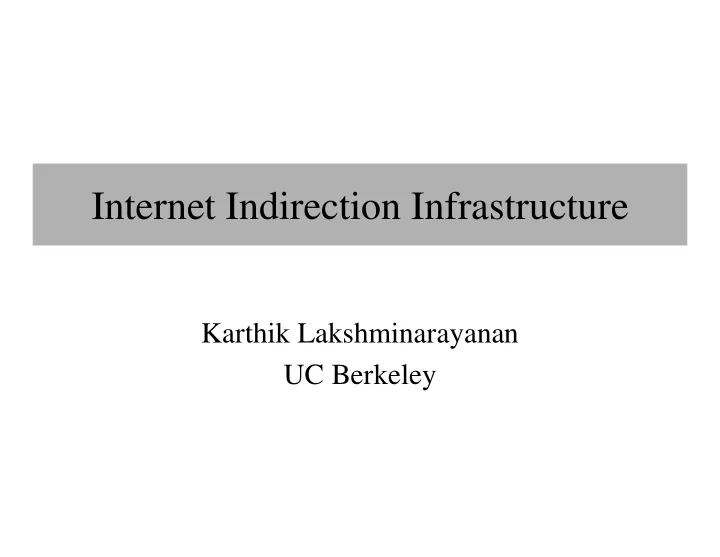

Internet Indirection Infrastructure Karthik Lakshminarayanan UC Berkeley
Contrasting LNA, HIP, and i3 • LNA = “Layered Naming Architecture” • LNA, HIP, i3: – All network architecture proposals – Separate location and identity • What are the differences?
i3 Overview • (Overlay) Forwarding Infrastructure that allows users to control routing and naming • Routing: – Senders, receivers can control routing in the network – Set up the routing entries in the infrastructure • Naming: – Fixed size IDs chosen by users/applications – ID typically identifies a service; can also identify end- hosts, etc.
i3 Overview • Basic primitive is indirection • Each packet is associated an identifier id • To receive a packet with identifier id , receiver R maintains a trigger ( id , R) into the overlay network data id data id Sender Receiver data R trigger id R
Mapping IDs • i3 is implemented on top of Chord – But can easily use CAN, Pastry, Tapestry, etc • Each trigger t = (id, R) or (id,id’) is stored on the node responsible for id • Use Chord recursive routing to find best matching trigger for packet p = ( id, data )
What i3 supports • Communication abstractions – Mobility, Multicast, Anycast • Service interposition – Receiver-driven, Sender-driven • Can combine primitives powerfully – Receiver-driven heterogenous multicast – Service composition with server selection (using anycast) • Enables many applications – NAT traversal, Secure VPN access – Protection against DoS attacks – IDS: route all packets through an intrusion detection box (e.g., Bro)
What i3 supports • Communication abstractions – Mobility , Multicast, Anycast • Service interposition – Receiver-driven, Sender-driven • Can combine primitives powerfully – Receiver-driven heterogenous multicast – Service composition with server selection (using anycast) • Enables many applications – NAT traversal, Secure VPN access – Protection against DoS attacks – IDS: route all packets through an intrusion detection box (e.g., Bro)
Mobility • Host just needs to update its trigger as it moves from one subnet to another Receiver (R, IP1) Sender id IP1 id IP2 Receiver (R, IP2)
Sender-driven Service Composition Use stack of identifiers in packets Service (S1) Service (S2) ([S1, id2,id3], data) ([id2,id3], data) (id3, data) Stack of IDs ([S2,id3], data) ([id1, id2, id3], data) (R, data) id2 S2 id R1 id1 S1 id R1 id3 R Sender Receiver (R) Receiver is unaware of transformations
Heterogeneous Receiver-driven Use stack of identifiers in triggers S_ MPEG/JPEG send(R1, data) send(id, data) Receiver R1 Sender id_ MPEG/JPEG S_ MPEG/JPEG (JPEG) (MPEG) send((id _MPEG/JPEG, R1), data) id (id_ MPEG/JPEG , R1) send(R2, data) id R2 Receiver R2 (MPEG) Sender is unaware of transformations
Using i3 as a Lookup Infrastructure • i3 employs short-cuts if both sender and recipient allow it • i3 is only used as a lookup infrastructure Service (S1) Service (S2) ([id1, id2, id3], data) id2 S2 id R1 id1 S1 id R1 id3 R Sender Receiver (R)
Using i3 as a Lookup Infrastructure • i3 employs short-cuts if both sender and recipient allow it • i3 is only used as a lookup infrastructure Service (S1) Service (S2) ([id1, id2, id3], data) id2 S2 id R1 id1 S1 id R1 id3 R Sender Receiver (R)
Protocol Stack (Native Apps) Receiver R e s t q u r e S D N DNS Client app Client app i d y = p l r e N S D send(id) Transport Transport i3 daemon send(id) i3 layer i3 layer send(IPi3) send(id) id R IPi3 IP IP
Status of i3 • Code publicly available: http://i3.cs.berkeley.edu • Supports Linux & Windows XP/2000 legacy applications • Several groups build applications on top of i3 – U. of Waterloo: delay tolerant networks – UIUC: service composition – U. of Tübingen (Germany): mobility, security
Contrasting HIP, i3 and LNA • Infrastructure: – HIP: rendezvous server – i3 : integrated forwarding infrastructure; can be used for lookup also – LNA: uses an external lookup infrastructure • Semantics of IDs: – HIP: IDs identify hosts – i3: IDs identify services; could also identify hosts – LNA: EIDs identify machines and SIDs services • Security: – HIP: authentication, integrity, transport anonymity/DoS resistance – i3 : IP anonymity, DoS defense at IP, rest through middleboxes – LNA: everything can be done through middleboxes
Recommend
More recommend